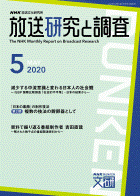All issues

Volume 70, Issue 5
The NHK Monthly Report on Broadcast Research
Displaying 1-5 of 5 articles from this issue
- |<
- <
- 1
- >
- >|
-
From the ISSP Survey on Social Inequality: Survey Results in JapanToshiyuki KOBAYASHI2020Volume 70Issue 5 Pages 2-21
Published: 2020
Released on J-STAGE: April 16, 2021
RESEARCH REPORT / TECHNICAL REPORT FREE ACCESSAs a member of the International Social Survey Programme (ISSP), the NHK Broadcasting Culture Research Institute conducted an ISSP survey on “social inequality,” whose aim was to explore the public awareness of various types of disparities in each society. This paper reports the results of the survey held in Japan in December 2019, centering on a time-series comparison with the results from the 1999 and the 2009 surveys on the same theme. Against the background of an increase in low-income population, the 2019 survey finds more people thinking “differences in income in Japan are too large” than twenty years ago. There were also an increase in those feeling Japan's “social structure” was that more lower-class population than the middle-class, and likewise, in terms of “class identification,” those finding themselves belonging to social classes below the middle increased. Meanwhile, with regard to the characteristics of Japanese society, there are decreases in those finding Japan a society where “having a good education is important for getting ahead in life” and where “money talks” and increases in those thinking “people care about the nature and the environment,” “people value human relationships,” and “efforts are justly rewarded.” Those agreeing with the latter three statements (“nature and the environment,” “human relationship” and “efforts”) remarkably increased among the youth, which shows the change in young people's awareness is largely impacting the change in the entire Japanese population's attitudes towards society.View full abstractDownload PDF (2508K) -
Akira MIYATA2020Volume 70Issue 5 Pages 22-55
Published: 2020
Released on J-STAGE: April 16, 2021
RESEARCH REPORT / TECHNICAL REPORT FREE ACCESSThe second part of the series analyzes the texts of Nihon no sugao (Japan Unmasked) (1957-1964), from the launch of the series in November 1957 to April 1960 in order to elucidate the production methods. A great number of texts were analyzed quantitatively, which was followed by a qualitative analysis of each text based on the results of the quantitative analysis. As a result, it is revealed that while Japan Unmasked during that time was influenced by preceding radio programs called “rokuon kosei” (audio documentaries: recorded sound compositions) as well as documentary films, the series gave birth to a number of basic production methods for TV documentaries. Among them, a method of identifying separate, individual realities as a specific social issue and developing an argument has been inherited by TV documentaries of today such as NHK Special and Close Up Gendai (Today's Close-up). A method of delicately portraying each individual reality as it is, inducing non-verbal feelings, has been handed down to programs such as Tsurube no kazoku ni kanpai [Tsurube's salute to families] and Document 72 Hours. As the paper discusses these production methods, the author also looks into some related topics from a new perspective, namely a concept of “TV documentary” advocated by Yoshida Naoya in 1960 and so-called “Nihon no sugao debate.”View full abstractDownload PDF (1734K) -
Based on Thousands of Production-Related Documents BequeathedSeiichi MURAKAMI, Ichiro HIGASHIYAMA2020Volume 70Issue 5 Pages 56-72
Published: 2020
Released on J-STAGE: April 16, 2021
RESEARCH REPORT / TECHNICAL REPORT FREE ACCESSYoshida Naoya (1931-2008) created epoch-making broadcast programs representing NHK in the latter half of the 20th century such as Taikoki (The Life of Toyotomi Hideyoshi) for the Taiga Drama (Annual Historical Drama) and Mirai e no isan (Legacy for the Future) documentary series. A great number of materials related to his works that had been kept at home and other places were endowed to the NHK Broadcasting Culture Research Institute by his family. The documents include program scripts, proposals, photos taken in the process of production, studio set plans, and musical scores for tunes used in his programs; several thousands of such pieces are stored in 54 boxes. To utilize the materials for future studies, the authors categorized them into five groups according to the characteristics of productions by age: (1) radio programs in the 1950s, (2) early TV documentaries, (3) pilot and experimental programs when he belonged to the department of pilot programs, (4) Taiga Dramas and Ginga terebi shosetsu (night-time TV drama serials), and (5) large-scale programs such as NHK Tokushu (later named NHK Special). The paper discusses how to make a good use of the materials for future studies and how to compile and archive them.View full abstractDownload PDF (1993K) -
Hiroyuki INOUE2020Volume 70Issue 5 Pages 74-75
Published: 2020
Released on J-STAGE: April 16, 2021
RESEARCH REPORT / TECHNICAL REPORT FREE ACCESSDownload PDF (1212K) -
Daisuke MIYAGAWA2020Volume 70Issue 5 Pages 76-77
Published: 2020
Released on J-STAGE: April 16, 2021
RESEARCH REPORT / TECHNICAL REPORT FREE ACCESSDownload PDF (1359K)
- |<
- <
- 1
- >
- >|